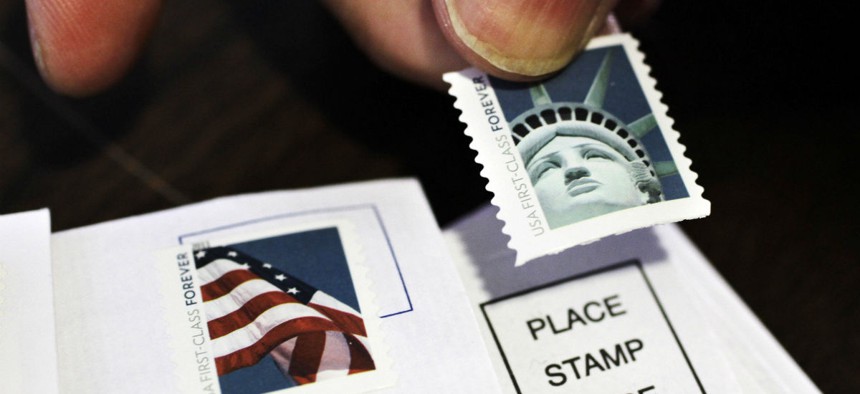
Paul Sakuma/AP file photo
Mail Will Soon Get Cheaper With USPS Rate Increase Set to Expire Next Spring
Oversight body gives Postal Service new deadline for ending recession-induced price surge.
Mail will get a few cents cheaper next spring, as the U.S. Postal Service’s regulator has set a new cap on how much revenue the agency can earn from its emergency price increase before it must cancel the temporary rate.
The Postal Regulatory Commission’s ruling will end the exigency rate a little more than two years after it went into place in 2014 and helped stabilize USPS’ previously shaky finances. The order will allow the Postal Service to raise about $4 billion from the price surge, up from the $2.8 billion the agency was originally permitted to collect.
The Postal Service asked for and instituted the emergency rate in 2013, citing the effects of the recession on its business to justify a 4.3 percent increase. Under a 2006 law, USPS can only raise its prices by the rate of inflation except under extraordinary circumstances.
With significant controversy, the Postal Service argued the recession constituted such a circumstance, and its oversight body -- the Postal Regulatory Commission -- obliged, but set a cap on the amount of money USPS could bring in as a result of the higher prices. The mailing agency was set to hit that ceiling in August, and it challenged the need for the cap in court. The mailing industry argued the recession never should have justified a rate increase, while the PRC said it had decided correctly.
A federal appeals court sided mostly with the PRC, denying the USPS contention that the emergency rates should become permanent. Instead, the court said, the aftereffects of the recession have become “the new normal,” and the Postal Service must adjust to that reality.
The court also ruled, however, PRC had arbitrarily decided USPS could only count one year of revenue from a customer lost due to the recession when determining the cap for how much money the agency can collect from the emergency rates. The court remanded the “count once” provision back to PRC, instructing it to use a more evidence-based approach to determine the effects of a lost customer. If, for example, a postal customer lost his job and decided to cancel his cable television subscription, USPS would lose the business of the cable company mailing his bill for as long as he went without his subscription, not just for 12 months.
In the new ruling, PRC accepted the Postal Service’s proposed methodology for counting mail volume losses due to the recession. The new calculation will allow USPS to collect about 40 percent more pieces of mail at the higher rate than PRC originally allowed.
The Postal Service said the ruling still shortchanged the agency.
“The recent decision does not fully restore the Postal Service for the significant mail volume and revenue losses associated with the great recession,” said Darlene Casey, a postal spokeswoman.
The Postal Service will have to give 45 days’ notice to alert customers when it plans to restore it prices back to their lower rate. That is expected to occur in about eight months.
“We believe that ending the exigent chapter will be good not only for customers of the USPS, but it also will enable the Postal Service to retain more of those customers and to focus on more long term strategic issues,” said Stephen Kearney, executive director of the Alliance of Nonprofit Mailers. “We urge the Postal Service to use the PRC order as a positive turning point for its future.”
For the Postal Service to turn the end of its rate surge into a positive, it will first have to deal with the more immediate negative. The emergency price was providing USPS hundreds of millions of dollars in bonus revenue each quarter since its implementation, helping the agency stay operationally profitable since the implementation of the rate.
Postal officials have long warned if the surge was not made permanent, the agency’s finances would once again fall into the red. Casey reiterated that sentiment on Thursday.
The PRC decision “clearly demonstrates there are significant pricing constraints in the postal law that impact the long-term financial health of the Postal Service, and reinforces the need for legislative reform of the Postal Service business model,” Casey said.
NEXT STORY: NSA Whistleblower Describes Ongoing Anguish







